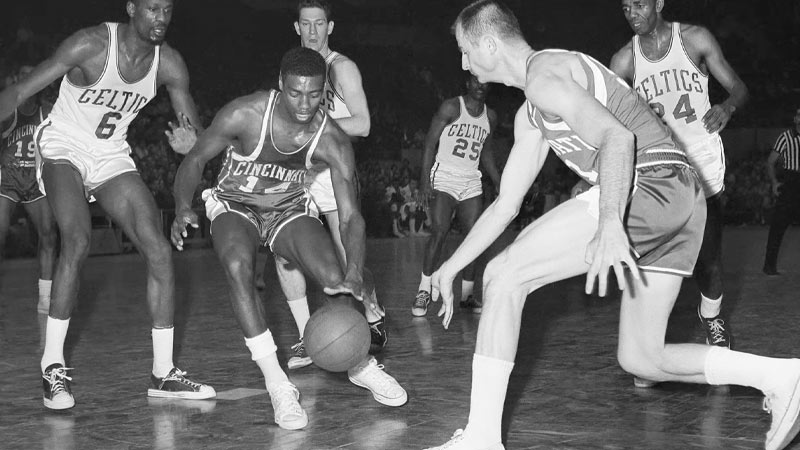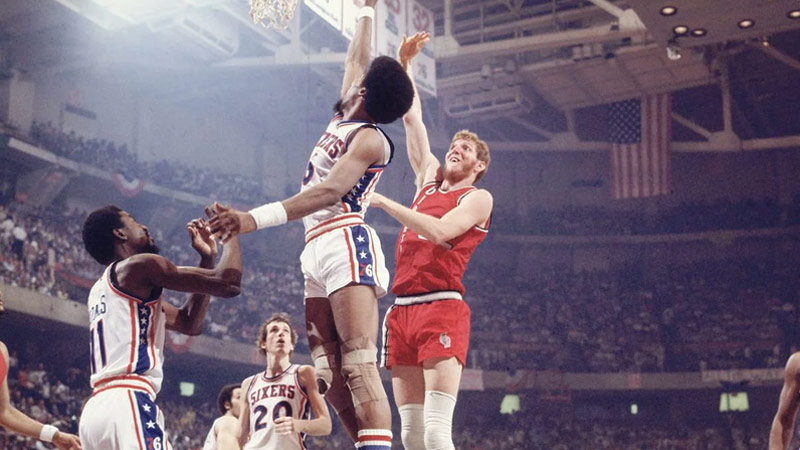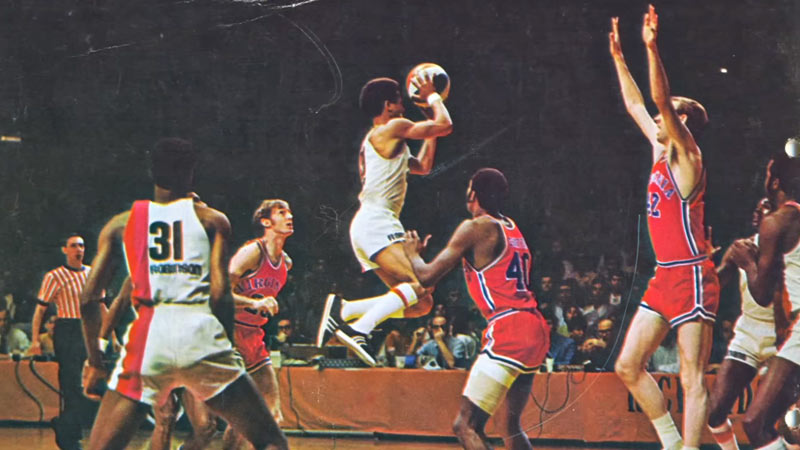The American Basketball Association (ABA) holds a significant place in the history of professional basketball in the United States.
Although its existence was relatively short-lived, spanning from 1967 to 1976, the ABA left an indelible mark on the sport.
In this article, we will explore the origins, and differences between the NBA, and the lasting impact of the American Basketball Association. Let’s dig deep into the matter in the following phases.
What is the American Basketball Association?
The American Basketball Association (ABA) was a professional basketball league that operated from 1967 to 1976. It started with 11 teams and eventually expanded to 10 teams at its peak.
The ABA introduced several innovations to the game, including the three-point line and a more fast-paced, high-scoring style of play. The league attracted notable players such as Julius Erving and George Gervin.
After facing financial challenges, the ABA eventually merged with the National Basketball Association (NBA) in 1976, leading to the adoption of some ABA innovations by the NBA, including the three-point line.
History of the American Basketball Association

The American Basketball Association (ABA) was a professional basketball league in the United States that operated from 1967 to 1976. During its brief existence, the ABA made a significant impact on the sport, introducing several innovative ideas and leaving a lasting legacy.
Here are some key points highlighting the history of the American Basketball Association:
Formation
The ABA was formed in 1967 as an alternative to the established National Basketball Association (NBA). Several businessmen, including Dennis Murphy, Gary Davidson, and Earl Foreman, were instrumental in founding the league. The ABA aimed to provide more excitement and a faster-paced style of play compared to the NBA.
Red, White, and Blue Ball
One of the most recognizable features of the ABA was its red, white, and blue basketball. This unique ball design was intended to enhance visibility for fans watching games on color televisions, which were becoming increasingly popular during that era. The ABA’s adoption of the vibrant ball became one of its distinct trademarks.
Free-wheeling style of play
The ABA introduced a more freewheeling and high-scoring style of basketball compared to the more structured game played in the NBA at the time. The league encouraged a faster pace, emphasized one-on-one play, and introduced the three-point line, which added an exciting new dimension to the game.
Innovative Rules
The ABA implemented several innovative rules that differentiated it from the NBA. In addition to the three-point line, the league introduced the 30-second shot clock (shorter than the NBA’s 24-second clock), a wider three-point arc, and a rule allowing players to touch the ball after it touched the rim, opening up more opportunities for offensive rebounds and putbacks.
Star Power
The ABA attracted numerous talented and charismatic players, including Julius Erving (known as Dr. J), George Gervin, Rick Barry, Moses Malone, and Artis Gilmore.
These players brought excitement, athleticism, and a dynamic style of play to the league, captivating fans and helping establish the ABA’s identity.
NBA-ABA Merger

Source: reddit.com
Financial difficulties and competition with the NBA eventually led to the ABA’s demise. In 1976, the NBA and ABA agreed to a merger, with four ABA teams (Denver Nuggets, Indiana Pacers, New York Nets, and San Antonio Spurs) joining the NBA.
The merger also led to the adoption of some ABA innovations by the NBA, including the three-point line.
Legacy
While the ABA’s existence was relatively short-lived, its impact on the sport of basketball was profound. The league’s innovations, such as the three-point line and a more up-tempo style of play, changed the game and became integral parts of basketball at all levels.
The ABA also played a pivotal role in expanding professional basketball’s popularity and paving the way for future generations of players.
The American Basketball Association’s legacy lives on through its contributions to the sport, the players who emerged from its ranks, and the enduring impact of its rule changes and style of play.
What Are the Differences Between the NBA and the ABA?
The NBA and ABA (American Basketball Association) were two separate basketball leagues that coexisted during the 1960s and 1970s.
While they shared similarities in terms of the sport they offered, there were distinct differences between the two leagues that shaped their identities and legacies.
Style of Play
One of the notable differences between the NBA and the ABA was their style of play. The ABA emphasized a more freewheeling and high-scoring style of basketball.
The league encouraged a faster pace, one-on-one play, and flashy moves, which added excitement and entertainment value to the games.
The ABA’s emphasis on a more dynamic and aggressive style of play attracted fans who sought a more fast-paced and visually appealing game.
In contrast, the NBA at the time focused on a more structured and team-oriented style of play, with an emphasis on fundamentals and team strategies.
Financial Stability
The NBA had a more stable financial foundation compared to the ABA. The NBA benefited from lucrative television contracts and the stability of its established franchises.
The league had been in existence for several decades and had established itself as the premier professional basketball league in the United States.
On the other hand, the ABA faced financial challenges due to limited revenue streams and a constant battle for market share with the NBA.
The ABA’s financial instability had an impact on various aspects of the league, including player salaries, team operations, and overall league sustainability.
Player Talent
While the NBA boasted many of the top players of the era, the ABA was not far behind in terms of talent. The ABA attracted several notable players who went on to become stars in both leagues.
Players like Julius Erving, George Gervin, Moses Malone, and Rick Barry showcased their skills and athleticism in the ABA before eventually making their mark in the NBA.
The ABA’s style of play, which allowed for more individual creativity and flair, enticed players to join the upstart league.
The ABA’s willingness to offer competitive contracts also played a significant role in attracting talented players.
Merger
Due to financial struggles and fierce competition, the ABA and NBA eventually merged in 1976.
The merger allowed several ABA teams to join the NBA, including the Indiana Pacers, San Antonio Spurs, Denver Nuggets, and others. The merger brought an end to the rivalry between the two leagues and led to a consolidation of talent.
It also led to the adoption of some ABA innovations, such as the three-point line, which became an integral part of the NBA’s game.
The merger helped the NBA solidify its position as the premier professional basketball league in the United States and paved the way for future expansion and growth.
Significance of ABA in Basketball
The American Basketball Association played a pivotal role in shaping professional basketball in the United States.
Despite its relatively short existence, the ABA’s impact on the sport cannot be understated. Some of the notable contributions of the ABA include:
Introduction of the Three-Point Line
One of the most significant contributions of the ABA was the introduction of the three-point line. The ABA implemented the three-point line in its inaugural season, and its success led to its adoption by the NBA after the merger.
The three-point line revolutionized the game, adding a new dimension and expanding offensive strategies.
The Attraction of Top Talent
The ABA’s innovative style of play and willingness to offer competitive contracts attracted top talent, including future Hall of Famers.
The league provided a platform for players to showcase their skills and gain recognition before eventually transitioning to the NBA. The ABA’s ability to compete for talent helped elevate the overall quality of professional basketball.
Influence on NBA Style
The ABA’s fast-paced, high-scoring style of play had a lasting influence on the NBA. After the merger, the NBA incorporated elements of the ABA’s style, resulting in a more up-tempo and exciting brand of basketball.
The ABA’s influence can be seen in the increased emphasis on individual creativity, highlight-reel plays, and fan engagement.
Competition and Merger
The ABA’s existence created intense competition with the NBA. Both leagues fought for market share, viewership, and player signings. The competition spurred innovation and improvements in both leagues.
Eventually, financial struggles and the ongoing rivalry led to the merger of the ABA and the NBA in 1976.
The merger allowed several ABA teams to join the NBA, expanding the league’s reach and solidifying its position as the premier professional basketball league in the United States.
The merger also led to the adoption of some ABA innovations, including the three-point line, which became an integral part of the NBA’s game.
Expansion and Growth
The ABA challenged the NBA’s monopoly and forced it to expand into new markets to compete. The ABA introduced basketball to cities like Denver, San Antonio, and Miami, which eventually became thriving NBA markets.
The ABA’s presence stimulated the growth and popularity of the sport in untapped regions.
Impact on the Sport
Despite its challenges, the ABA left a lasting impact on the sport of basketball. The league introduced innovations such as the three-point line, which revolutionized the game and became an integral part of basketball at all levels.
Fans recognized the ABA’s contributions and appreciated the lasting influence it had on the sport they loved.
FAQs
Did any ABA teams win championships?
Yes, several ABA teams won championships, including the Indiana Pacers, Kentucky Colonels, and New York Nets. These teams enjoyed success both during the ABA era and after the merger with the NBA.
How many teams were in the ABA?
The ABA began with 11 teams in its inaugural season. Over the course of its existence, the league expanded and contracted, with a peak of 10 teams during the 1974-75 season.
Why did the ABA eventually merge with the NBA?
The ABA faced financial challenges and fierce competition from the more established NBA. The merger allowed the ABA teams to join the NBA and brought stability to the professional basketball landscape.
What happened to the ABA players after the merger?
Many ABA players successfully transitioned to the NBA after the merger. Some players, such as Julius Erving and George Gervin, went on to have illustrious careers and became legends in both leagues.
Is the ABA still active today?
No, the ABA ceased operations after the merger with the NBA in 1976. However, its impact and legacy continue to be felt in the modern game.
Bottom Line
The American Basketball Association played a crucial role in the evolution of professional basketball.
Its innovative style of play, the introduction of the three-point line, and its ability to attract top talent left an enduring legacy.
While the ABA may be gone, its impact on the sport remains evident, and its influence can be seen in the exciting, fast-paced nature of the game we know and love today. Best of luck.







